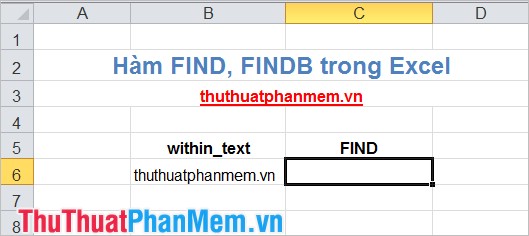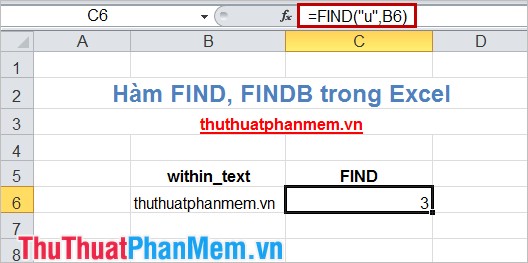Find, FindB functions in Excel - The function finds a text string in another document in Excel
The Find and FindB functions help you find a text string in another text and return the value as the location of the text string to be found in the search text. Depending on the different default languages that you apply the FIND or FINDB function properly.

To better understand the FIND function, FINDB you follow the article below:
Description
FIND, FINDB are functions that find a text string in another text, the return value is the first position of the first character in the search string.
- FIND function: for languages that use single-byte encoding (SBCS), always count every single-byte or double-byte character regardless of the default language, of Windows & Office.
- FINDB: for languages that use double-byte encoding (DBCS), FINDB counts each double-byte character as 2 when you set the default language to DBCS. Otherwise, FINDB will count each character as 1.
The languages that support DBCS include: Japanese - Japanese, Chinese (Simplified) - Simplified Chinese, Chinese (Traditional) - Traditional Chinese and Korean - Korean.
Syntax
= FIND (find_text, within_text, [start_num])
= FINDB (find_text, within_text, [start_num])
Inside:
- find_text: text string to find, is the required parameter.
- within_text: text containing the text to be searched, is the required parameter.
- start_num: the starting position of the search within within text, the first character of within_text is the position 1 position that gradually increases with the characters of within_text. If you omit start_num, it defaults to 1, which is an optional parameter.
Note
- FIND and FINDB functions are case sensitive and do not allow the use of wildcards. If you need to distinguish uppercase and lowercase letters and use wildcards, you should use SEARCH or SEARCHB.
- If the text string you are looking for is blank text "", FIND will return the position of the first character within within_text (the position of start_num or 1 if start_num is omitted).
- If the text string to find (find_text) does not appear in the find text (within_text) of the FIND function, FINDB will return the error value.
- If start_num is less than 0 or greater than the length of within_text, FIND, FINDB returns the error value.
- Use start_num to skip a specified number of characters without searching. The FIND function always returns the number of characters counting from the beginning of within_text, counting all the characters you ignore when using start_num greater than 1.
To better understand you to follow some of the examples below:
For example
Give the text string (within_text) as follows:

1. Find the position of the first u in the text string of cell B6.
Applying FIND: = FIND ("u", B6) returns 3.

2. Find the position of the first letter h in the text string of cell B6 starting with the 8th character.
Applying FIND function: = FIND ("h", B6,8) The result is 10 because the function counts the characters you ignore when using start_num is 8.

The above article has given you the syntax and examples to help you know how to use the FIND and FINDB functions. From now on, whenever you need to know where the text string appears in another text, you can apply FIND and FINDB functions. Good luck!
You should read it
- How to use Excel's VALUE function
- How to use the FIND function in Excel?
- MID and MIDB functions to cut strings in Excel
- String (String) in PHP
- Save time with these text formatting functions in Microsoft Excel
- How to use the Search function in Excel
- The LEFT function, how to use the left-hand string cutting function in Excel
- How to fix the SUM function doesn't add up in Excel
May be interested
- Text and string processing functions in Excel
 in excel, there are many groups of functions to help you process data quickly, one of which is a group of functions for processing text and strings. the following article summarizes the text processing functions and strings in excel.
in excel, there are many groups of functions to help you process data quickly, one of which is a group of functions for processing text and strings. the following article summarizes the text processing functions and strings in excel. - SEARCH () and SEARCHB () functions in Excel
 the search () function and the searchb () function are two functions that help you process strings in excel. when you need to find the starting position of a substring in a text string without case or case, you use the search () or searchb () function.
the search () function and the searchb () function are two functions that help you process strings in excel. when you need to find the starting position of a substring in a text string without case or case, you use the search () or searchb () function. - How to use the Search function in Excel
 the search function in excel is used to search for the position and order of a text string, so you can find the position of the word or the data you need.
the search function in excel is used to search for the position and order of a text string, so you can find the position of the word or the data you need. - LEN () and LENB () functions in Excel
 the len () function returns the number of characters in the input text string. the lenb () function returns the number of bytes used to represent characters in the input text string. the lenb function only comes to 2 bytes per character when the default language is one of the languages that supports dbcs.
the len () function returns the number of characters in the input text string. the lenb () function returns the number of bytes used to represent characters in the input text string. the lenb function only comes to 2 bytes per character when the default language is one of the languages that supports dbcs. - The MID function in Excel, how to use the MID function, and examples
 the mid function in excel, how to use the mid function, and examples. the mid function in excel is a function of the text function group, you use the mid function if you want to cut the string in the middle of the text string when processing the string. if you do not know or do not understand the mid function, then you
the mid function in excel, how to use the mid function, and examples. the mid function in excel is a function of the text function group, you use the mid function if you want to cut the string in the middle of the text string when processing the string. if you do not know or do not understand the mid function, then you - LEFT function in Excel, how to use LEFT function and illustrative examples
 left function in excel, how to use left function and illustrative examples. left function in excel is a function of string processing function, you use left function when you need to cut the character string to the left of the text string. if you need to learn more about mid functions, be patient
left function in excel, how to use left function and illustrative examples. left function in excel is a function of string processing function, you use left function when you need to cut the character string to the left of the text string. if you need to learn more about mid functions, be patient - CONCATENATE function (string concatenation function) in Excel
 use the concatenate function when you want to concatenate existing text strings into a single, complete text string. for the syntax and usage of the concatenate function, follow the article below.
use the concatenate function when you want to concatenate existing text strings into a single, complete text string. for the syntax and usage of the concatenate function, follow the article below. - ENCODEURL function - The function returns a query string with URL code in Excel
 encodeurl function: the function returns a query string with the url code. support functions from excel 2013 onwards. syntax: encodeurl (text)
encodeurl function: the function returns a query string with the url code. support functions from excel 2013 onwards. syntax: encodeurl (text) - How to fix the SUM function doesn't add up in Excel
 in the process of summing with sum in excel, you will encounter some errors such as not jumping the number, not adding the sum. so how to handle this problem?
in the process of summing with sum in excel, you will encounter some errors such as not jumping the number, not adding the sum. so how to handle this problem? - RIGHT () and RIGHTB () functions in Excel
 the right () function returns the result as one or more final characters in a text string based on the number of characters you give. the right () function always comes with every 1 character whether it is single byte or double byte or whatever the default language is.
the right () function returns the result as one or more final characters in a text string based on the number of characters you give. the right () function always comes with every 1 character whether it is single byte or double byte or whatever the default language is.










 The INT (Function rounds a number down to the nearest integer of a number) in Excel
The INT (Function rounds a number down to the nearest integer of a number) in Excel The Match function (the function searches for a specified value in an array or cell range) in Excel
The Match function (the function searches for a specified value in an array or cell range) in Excel The MODE function (returns the value with the most frequent occurrence in an array or data range) in Excel
The MODE function (returns the value with the most frequent occurrence in an array or data range) in Excel Hide value 0 in Excel
Hide value 0 in Excel Use Sparklines in Excel
Use Sparklines in Excel The MIN and MAX functions (the smallest and largest value functions) in Excel
The MIN and MAX functions (the smallest and largest value functions) in Excel